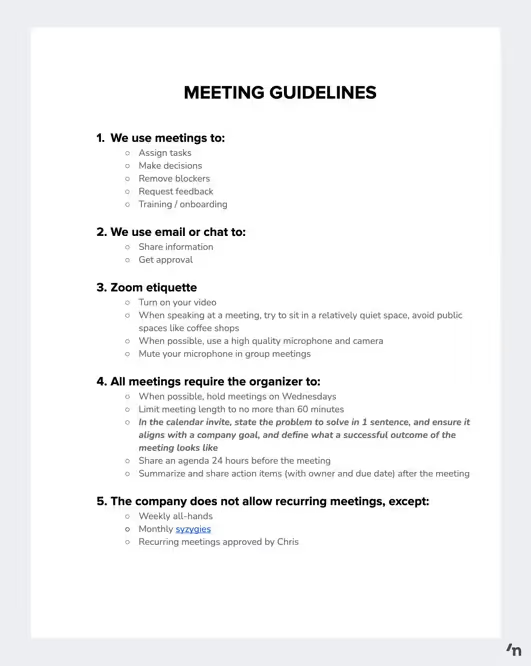 Blog
Blog Meetings Are Thieves. Here’s How We Prevent Our Time From Being Stolen
Meetings Are Thieves. Here’s How We Prevent Our Time From Being StolenMeetings Are Thieves. Here’s How We Prevent Our Time From Being Stolen

We’ve all experienced bad meeting cultures where meetings become political tools, waste everyone’s time with information sharing, or devolve into micro management (think “weekly check-ins”). Individuals don’t like them—no one wants to be part of meetings that distract from the real work. And they’re expensive for companies, too.
That’s why understanding your company’s meeting culture scorecard is so important. Whether you're looking to implement better meeting guidelines, run more effective meetings, or do a full meeting audit, the first step is recognizing where your team stands—and what needs to change.
But meetings are just... easy. It’s easier for someone to “talk it out” than sit down and write about the problem they’re trying to communicate. And (some managers think) it’s easier to speak up about concerns or blockers when meeting face-to-face.
"Perhaps the CEO's most important operational responsibility is designing and implementing the communication architecture for her company."
- Ben Horowitz, Cofounder and General Partner at a16z
At Nuffsaid we’ve been intentional about our meeting culture and have used tactics I think other teams may benefit from applying. This piece is a blueprint for what we’ve done. Read it, apply the parts that make sense for you, and connect with me to share what you’ve learned.
Step 1: Conduct a Meeting Audit Using a Scorecard
Pulse check: Does your company have a bad meeting culture?
Before I share what we’re doing at Nuffsaid, it’s useful to audit your company’s meeting culture. I recommend setting meeting guidelines as a preventative measure, but if you already have an established “bad meeting culture,” you may need to do extra work to change how people operate.
To do a meeting audit, consider using this 5-question survey. Then, compare the responses to this “poor, average, excellent” Meeting Culture Scorecard to understand where your culture stands.

1. What percentage of the team's time is spent in meetings every week?
20% of the average 5-day work week equals about 2 hours per day in meetings. No individual contributor should be spending more than an average of 2 hours per day in meetings. If your team responds to the survey saying they spend more than 25% of their week in meetings, consider combing through their schedule and working with the meeting organizers to see whether those meetings are necessary or if the attendee list could be shortened.
Individual contributors should aim for 10% or lower (an average of 1 hour per day in meetings), and managers should aim for 20% or lower. If organizers are required to take a hard look at every single meeting to determine whether there needs to be one, they’ll find that many are being used to share information or get approval—both of which can be done via email. And some won't have a purpose or agenda at all. Kill those meetings.
And for the meetings that survive, organizers must consider the time allotted per meeting. Parkinson’s Law says that work expands to fit the time allotted. If your meeting is scheduled for an hour, it’s probably going to take an hour. If it’s scheduled for 30 minutes, you’ll figure out a way to get everything done in that time. If organizers cut all their meetings in half, they’ll be surprised how much value they still get from the shorter meeting.
2. What is the primary purpose of meetings at your company?
Meetings often focus on one of the following categories:
- Share information ← Poor use of time
- Get approval ← Poor use of time
- Assign tasks
- Make decisions
- Remove blockers
- Request feedback
- Training / onboarding
As most companies grow, in an attempt to keep everyone included about what’s happening, they focus their meeting time on sharing information. Unfortunately, meetings are an extremely inefficient way to share information for large groups since much of the information won’t be interesting or relevant for much of the audience. It’s the meeting organizer’s job to find other ways to distribute relevant information to the right people. An effective example we’ve seen is when managers direct message (in Slack) every person on their team who needs an important piece of information.
Effective meetings should focus on decision-making and removing blockers, not status updates.
3. Except for all-hands and department meetings, how often do meetings have more than 5 attendees?
Except for company or team all-hands, meetings should rarely have more than 5 people in attendance. If your meeting is focused on something productive, like making a decision, then it’s difficult to hear everyone’s perspectives and allow room for debate when too many people are in the room.
Sometimes when meetings have more than 5 attendees it’s because there are some people who have been invited for purely political reasons, like to have a department presence with no goal of how that person should participate. It usually sounds something like this: “We should get Alison from Product to attend this meeting.” Or, “I should attend this meeting so I’m visible to Andrew.”
When attendance is political and not about getting value out of a meeting, it’s a sign there are some deep-rooted issues and fixing your meeting culture may be a step in the right direction.
Here’s how we’re doing it at Nuffsaid, in the hopes that you’ll use this blueprint for the benefit of your team.
How we've established meeting guidelines at Nuffsaid
When starting Nuffsaid, I knew I’d want to protect the team’s time from meeting creep as we grew. So my co-founders (Hari and Nick) and I created a rough outline of meeting guidelines that eventually was refined to the following:

Core to our guidelines are what we don’t use meetings for, how we think about recurring meetings, and why we help team members prepare.
We don’t use meetings to share information or get approval. There’s no reason to get everyone together for status updates or sharing context. They can be easily managed over chat or email.
We bundle all recurring meetings on the same day, when possible. I wholeheartedly agree with Paul Graham’s argument in Maker’s Schedule, Manager’s Schedule that makers need large chunks of uninterrupted time. It’s difficult for the human brain to switch our working mode quickly, especially when shifting our focus from meetings to deep work. So companies should encourage bundling meetings closely together, leaving long stretches of uninterrupted time to get the actual work done.
One of the ways we accomplish this at Nuffsaid is by scheduling all recurring meetings on Wednesdays. The actual day doesn’t matter as long as everyone agrees to the same day.
We share an agenda at least 24 hours before the meeting. This behavior is more important than it may initially seem. Some people don’t perform as well in meetings because they don’t process information on the spot by talking things out. These team members may prefer to think about a topic ahead of time, come up with an opinion, and then share that point of view with the group.
Individuals who operate this way often have the most elegant solutions to problems, just not under pressure. It’s in the company’s best interest to hear from all the voices of a team, not just from those who think well on their feet.
We assign ownership for the company’s meeting culture. As the company scales, the problem of meeting creep will be more persistent. Someone needs to be accountable for vetoing recurring meetings that aren’t useful—as a startup, that’s probably the CEO. As the company grows, each department should assign owners over this responsibility.
And we follow some basic Zoom meeting etiquette expectations. Because our main human connection to each other happens over video, it’s very important that we adopt these simple standards for online meetings:
- When possible, turn your camera on. This is a good habit because it shows others you're present. Especially when working remotely, having our video on helps us feel more connected to each other.
- Mute anytime you're not actively communicating, so others don’t hear the dogs barking.
- Try to find a relatively quiet space to join the meeting when you know you’ll be speaking.
If your company is doing a good job of protecting you from useless meetings, it means any meeting you're invited to is actually valuable. You are there for a reason, so it's important to focus and be involved.
If you’re not getting value from a meeting, let the meeting host know and consider skipping future meetings.
But what about remote work?
Because of Nuffsaid’s mindful meeting culture, we spend more time doing actual work than many other companies.
The downside, though, is that people can feel disconnected from their team and company in a remote work environment. If you spend all your time working and not in meetings, naturally there will be fewer chances for interaction.
This is something I'm monitoring. Given that we've been in business a few years and I have not seen any signs of this, I would say it's only a risk if not well-managed.
Here's how we're offsetting the risk of people feeling disconnected:
We offset the risk of team members feeling detached from their peers by keeping a steady flow of other ways to stay connected that aren’t typical meetings.
For one, we hold a weekly company huddle and monthly 1:1s.
We use the company huddle to discuss progress and organization-wide news. Customers are invited to the huddle in the form of customer feedback, and we share videos of feedback from user tests.
Everyone in the company has monthly 1:1s (internally called “Szygies”—here’s the format for those). We made our 1:1s monthly so they don’t become monotonous or time-consuming for either party. Feedback should be shared continuously and 1:1s aren’t for status updates, so meeting monthly to discuss career goals, engagement with their work, and broader company feedback works.
We host fun gatherings. We do team "social meals" monthly, and weekly "water coolers."
The monthly team meal (sometimes we do breakfast, other times dinner) is a time where everyone that wants to join can catch up on each other’s lives outside of work. The meetings are structured so everyone participates and discusses the same topics. Past topics include “What book or show are you into these days?” and “If you could do it all over again, what career path would you choose?” Last year before the holidays I asked everyone to share some of the best gifts they’ve received or given. I got some good ideas out of that one. And another: early on during the Covid-19 outbreak, I asked for everyone’s take on whether we should go remote permanently. The majority of the team said yes.
The (optional) water cooler meetup happens every week so employees can chit-chat about anything. They’re intended to be a place for banter and camaraderie-building.
Final Thoughts: Make Every Meeting Count
When meetings are used appropriately, they’re powerful. But when misused, they steal time and drain morale.
As a rule of thumb:
For every hour in a meeting, spend another hour preparing.
Creating a Meeting Culture Scorecard and implementing clear meeting guidelines helps teams reduce waste, increase engagement, and improve decision-making.

















.svg)